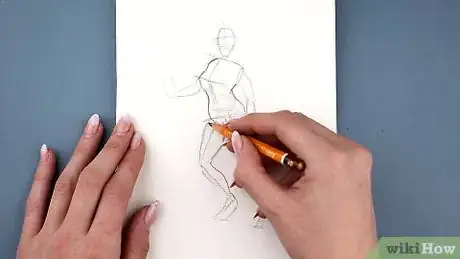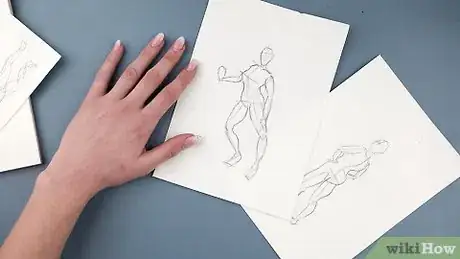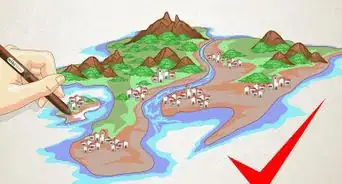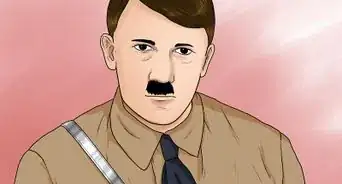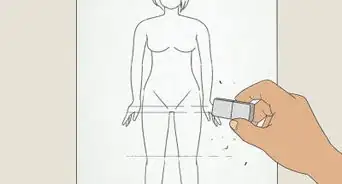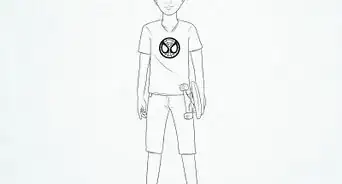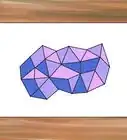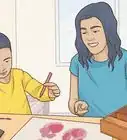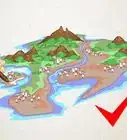This article was co-authored by Claire Wentzel. Claire Wentzel is an award-winning Artist and Strategic Creative Consultant. Her business, Red Rose Studios, is based in Las Vegas, Nevada, where she also serves on the Clark County Public Art Committee. With over 20 years of experience, she specializes in mixed media participatory art, brand messaging, and building organizational culture. She earned her BA in Fine Art with Distinction from the University of Colorado-Boulder and completed a painting residency at the International School of Painting, Drawing, and Sculpture. Her chalk mural work has been featured in EdHat and I Madonnari Italian Street Painting Festival advertising.
This article has been viewed 270,413 times.
The term "gesture drawing" is to capture the essence of the movement, weight, and inflexion of a human figure, in a long or short time, rather than to present a realistic rendering of details. Gesture drawing is a pedagogical tool--it is hard to imagine an art school that does not have at least one classroom packed with students trying to capture 30-second timed poses--but it also has many practical purposes. The speed and style of gesture drawing allow the artist to effectively capture motion and to sketch out the general character of something in motion, indispensable qualities if you want to draw an animal in your nature journal or if you want to make a quick sketch of a runner. More than anything, gesture drawing requires practice, but a few tips can't hurt either.
Steps
-
1Choose a subject. In every art curricula, gesture drawing is associated with figure drawing, that is drawing the human figure, usually from the model's poses. The subject of your gesture drawing, however, can be just about anything, just as long as you have something the essence of which you can try to capture. In the beginning, it's probably a good idea to sketch stationary objects in various angles and learn perspective in order to be able to capture the subject in a more precise way. You can then either go on and practice figure drawing on static images.
- Most artists use websites for their static gesture drawings, but you can also find videos on YouTube which will help you get better with decreasing time. Remember that gesture drawing is not drawing the figure in detail, but the gesture, so the motion behind the movement, and the weight associated with the pose.
-
2Find the line of action and the negative space surrounding your subject. The most important part of gesture drawing isn't precision but finding the line of action. Through that line of action, you can place the varying features of your drawing such as the ribcage, the hips, and make a coherent gesture throughout.Advertisement
-
3Consider negative space. The negative space is the space surrounding your subject. This can be useful to determine the distance from one part of the subject to the next. Usually, the line of action is located where the vertebral column is, but it can go further than that if the subject is having a long, fluid line of action you can see.
-
4Find the main forms of the subject. A human body, or anything in nature, is a succession of man-made shapes such as spheres, cylinders, cubes etc. While you have found the line of action, it is useful to then add the ribcage and the arm in simple lines first, then build on those shapes at a later time. After all, you are here to capture the motion, but if your gesture is good, there is nothing that prevents you from going further at your leisure. Remember to always keep it simple, and build on.
-
5Give short glances at the subject rather than keep your gaze on it. The reason behind this is that unless both items are in front of you, it is near impossible to draw a first gesture drawing without going back on the paper. This is why, to make it shorter, you glance first, find the line of action, then draw it.
-
6Find all the other features that fit in with your subject in an easier way.
- S and C curves. Living things will, at any given point, have one part or group of parts that are having common curves, which can be easily found throughout the figure. A human body can have S curves and C curves, such as for example the female body, which vertebral column bears an S curve shape, and the buttocks would have a C shape, contour wise. Remember that it is only through daily practice that it will get easier, and by finding those guidelines, you will certainly win time.
-
7Do not draw in contour lines. When drawing the human body, contour lines may be drawn to represent the limbs, torso, and even the head. In a way, these are just outlines, but they deter you from learning the real movement itself. A stick figure is a body drawn with very simple lines, and because only single lines are used, it's a two-dimensional representation. Because you are trying to capture the essence of the subject very quickly, you don't have time to draw its individual parts in any real detail. Drawing in shapes, or bits of the entire shape, such as the arc when an arm is folded simply shows that these parts do exist, and the lines give some idea of what those parts are doing.
-
8Keep your hand moving. The entire time you are drawing a gesture drawing, your hand should be in motion. The idea is that you let the image transfer directly from your eyes to your hand without thinking about it. Stop your hand, and you'll suddenly be separated from the action of drawing. You'll start thinking.
- Hold your pencil loosely and keep your motions fluid. Artists sometimes use gesture drawing as a warm-up to other kinds of drawing because it gets the muscles of your arm and hand loosened up. It does this because you try to just let yourself go. Relax and let your hand and arm move freely. You're not trying to color within the lines.
- Limit the time you spend on each portion of the drawing. Not only should you not stop drawing, but you should also not keep drawing in any one place for too long. For practice, try to limit yourself to five or six seconds in any one area. Try to capture that part of the subject as well as you can in that time, and then move on. You could jump from working on the foot to working on the hand to drawing the head. Draw wherever your eyes go and don't worry about trying to use a logical order or making sure that everything's connected perfectly.
- Don't erase. It is always a temptation to try to "fix" your work or try to think through your next move. Don't give in to this temptation. If you never stop drawing, and if you keep your eyes shifting from your paper to the subject as much as possible, you shouldn't have a problem with this.
-
9Set a time limit. When gesture drawing is taught in classes, a model will usually switch poses every 30 seconds to two minutes. This is good practice to push yourself to draw more quickly and, more importantly, to quickly ascertain the essence of your subject. It also has some practical applications, because if you ever try to draw a butterfly in the real world, you never know just how much time you'll have to do so before it flies away and is lost forever. Think of gesture drawing in this way. You are trying to draw a person or thing and represent its very soul in a fleeting moment. Wait a minute, wait for a second, or even blink an eye, and everything may have changed.
Expert Q&A
-
QuestionHow do I get better at drawing poses?
 Claire WentzelClaire Wentzel is an award-winning Artist and Strategic Creative Consultant. Her business, Red Rose Studios, is based in Las Vegas, Nevada, where she also serves on the Clark County Public Art Committee. With over 20 years of experience, she specializes in mixed media participatory art, brand messaging, and building organizational culture. She earned her BA in Fine Art with Distinction from the University of Colorado-Boulder and completed a painting residency at the International School of Painting, Drawing, and Sculpture. Her chalk mural work has been featured in EdHat and I Madonnari Italian Street Painting Festival advertising.
Claire WentzelClaire Wentzel is an award-winning Artist and Strategic Creative Consultant. Her business, Red Rose Studios, is based in Las Vegas, Nevada, where she also serves on the Clark County Public Art Committee. With over 20 years of experience, she specializes in mixed media participatory art, brand messaging, and building organizational culture. She earned her BA in Fine Art with Distinction from the University of Colorado-Boulder and completed a painting residency at the International School of Painting, Drawing, and Sculpture. Her chalk mural work has been featured in EdHat and I Madonnari Italian Street Painting Festival advertising.
Award-Winning Artist and Strategic Creative Consultant Try doing warm-up poses that are 30 seconds long. I love this exercise, because it forces you to get down to the essential information as quickly as possible, because you don't have time to get bogged down in the details. I think it's just a matter of doing it repetitively and giving yourself the freedom to have it look like whatever it's going to look like.
Try doing warm-up poses that are 30 seconds long. I love this exercise, because it forces you to get down to the essential information as quickly as possible, because you don't have time to get bogged down in the details. I think it's just a matter of doing it repetitively and giving yourself the freedom to have it look like whatever it's going to look like. -
QuestionI noticed that my gestures always seem to have an elongated torso from the waist to the breasts, like she was stretched out. I don't even realize I'm doing it. Is there something I can do to fix this?
 Community AnswerJust try to draw shorter lines for the torso. Be mindful of it when you're drawing and keep practicing until it comes naturally. You can use a reference or practice tracing over pictures of real people. This way, you'll get use to the figure of an actual person and will be able to replicate without tracing.
Community AnswerJust try to draw shorter lines for the torso. Be mindful of it when you're drawing and keep practicing until it comes naturally. You can use a reference or practice tracing over pictures of real people. This way, you'll get use to the figure of an actual person and will be able to replicate without tracing. -
QuestionWhat if I just can't draw?
 Community AnswerNo one can't draw. Just keep practicing and getting more comfortable drawing, and your abilities will improve.
Community AnswerNo one can't draw. Just keep practicing and getting more comfortable drawing, and your abilities will improve.
Expert Interview
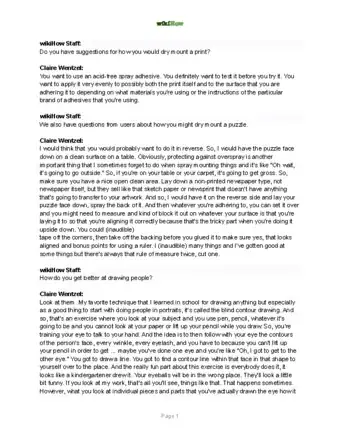
Thanks for reading our article! If you'd like to learn more about becoming an artist, check out our in-depth interview with Claire Wentzel.
References
About This Article
A gesture drawing is a kind of figure sketch that is meant to capture a sense of movement or weight without focusing on realism or fine details. To get started, choose a subject, whether it’s a live model or a photo of a person. Look at your model and try to determine a line of action through their pose, which will form the foundation of your drawing. For instance, if you’re looking at a picture of a dancer performing an Arabesque, the line of action might be a curve passing from the end of their upraised arm, through their torso, and along the leg that’s extended behind them. Draw in the line, but don’t add any details yet. Next, sketch in any areas of negative space around your subject, since this will help you determine the distances between the parts of their body as well as any other objects you want to fill in. Finally, fill in the major forms that make up the figure. Instead of trying to draw the person all at once, try to break them down into different shapes, like spheres, cubes, or cylinders. As you work, just take quick glances at your subject instead of staring at them and trying to spot every minor detail. Remember, you’re just trying to create a general impression. Try to keep your hand moving the whole time instead of lingering over any one part of the drawing. For more tips, like how to set a time limit for your gesture drawing, read on!

